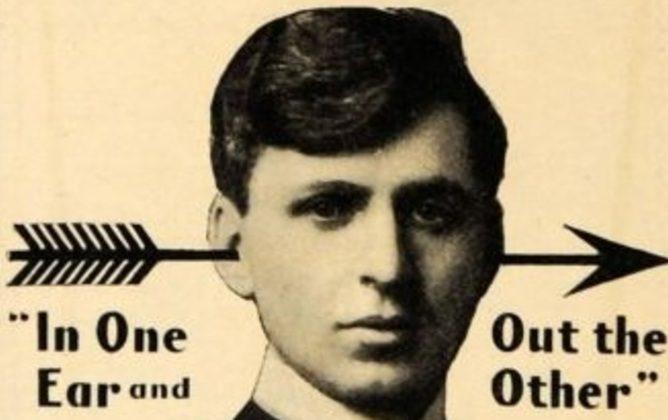Brain-training programmes are all the rage. They are part of a growing digital brain-health industry that earned more than US$1 billion in revenue in 2012 and is estimated to reach US$6 billion by 2020. The extent to which they actually improve brain function remains hotly debated. But there is agreement that brain-training, as a commercial phenomenon, is relatively new. Cogmed was founded in 2001, Posit Science was incorporated in 2002, and Brain Age for the gaming device Nintendo DS was first released in 2005.
So you might think the line “Build mind just as the physical instructor builds muscle” is taken from marketing for one of these companies. In fact, it is from an advertisement for a 100-year-old mind-training product, which was used by more than 500,000 members, including a British Prime Minister and the founder of the Scouting Movement. Unlike the mnemonic systems that came before it, this programme, called Pelmanism, focused on the same mental functions – such as attention, concentration, and creativity – targeted by modern brain-training programmes.

Previous systems of “memory-training” were quite popular in 19th-century Britain. These mnemonic systems, such as Mark Twain’s Memory Builder, involved a set of strategies or tricks to better recall facts, say, names or dates. Pelmanism evolved from one such mnemonic system developed in London at the turn of the 20th century into something that, by the start of World War I, didn’t look that much different from modern brain-training.
The Pelman Scientific Mind Training Program was advertised in periodicals like The Strand and Popular Mechanics. Members, or “Pelmanists” as the programme called them, were mailed booklets with titles such as “Concentration”, “Knowledge and the Senses”, and “Memory and the Principles of Mental Connection.” Each booklet started with an explanation of the topic that reflected a selection of then-contemporary pop psychology, such as William James’s views on developing habits or auto-suggestion, an early 20th century self-hypnosis technique.
After these short readings, participants filled out sheets of exercises to mail in for review by the teachers of the Pelman Institute. They also were instructed to practice brief games, such as quickly adding the number of dots on a series of dominoes. One task that you might recognise as memory or concentration involved finding matches among a set of flipped over playing cards. Pelmanism is still used as a name for this simple game.
A historical review of Pelmanism in the book Psychological Subjects by Mathew Thomson mentions that a wide swath of the middle class, from clergymen and teachers to government officials and members of the military, participated in the programme. Personal journals from the period show that Pelmanists practised the system a few minutes each day. Eventually the programme was expanded worldwide, with offices in the US, India, South Africa and beyond.
The origins of Pelmanism can likely be traced back to journalist William Ennever and his work with CL Pelman and a certain Professor Loisette. The latter two founders may have been using assumed names, and their standing as “psychologists” is questionable. The programme itself peaked in popularity sometime shortly after World War I, when, as Thomson mentions in his book, proponents of the system went so far as to call for a “Ministry of Pelmanism” in the UK. By the start of World War II, however, Ennever was in financial ruin, and the programme was in decline.
A hundred years later, what can we learn from this movement? First, it shows that public interest in brain-training isn’t new. Neither is the belief that certain mental functions, like attention or creativity, can be improved. Also, there are many other mind-training programmes from throughout the 20th century that have been forgotten – or largely ignored – by contemporary researchers. These include Catherine Aiken’s 1899 Exercises in Mind Training, and Instrumental Enrichment and Project Intelligence in the 1970s and 1980s.
The larger research questions behind brain-training, such as how improvement on trained tasks might transfer to every-day life, have yet to be fully addressed. Some early cognitive-training programmes, such as Instrumental Enrichment, have sizable bodies of research attached to them that might help answer these questions and could inform the development of future cognitive-training systems. Researching these early mind-training programmes might not help cure “grasshopper mind” or “scatter brain”, as the Pelmanism advertisements promised, but it may get psychologists just a little closer to figuring out what actually works.
Ben worked as a game designer for Lumosity.com prior to starting his PhD program. This article was originally published on The Conversation. Read the original article.
